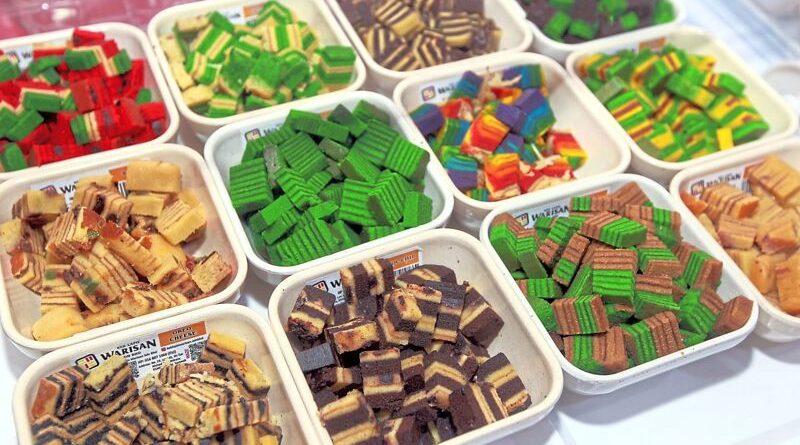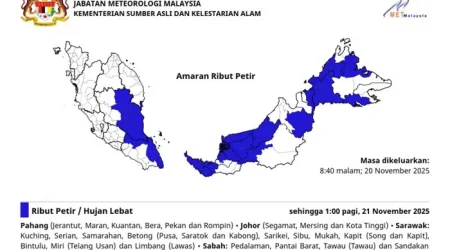Experience Sarawak’s vibrant gastronomical scene
A sweet fragrance enveloped the air as we arrived at Kek Lapis Warisan at Jalan Tun Ahmad Zaidi Adruce in Kuching, Sarawak. The pleasing aroma of butter wafted from the kitchen, leaving us curious over what to expect.
Kek lapis, Sarawak’s multi-layered traditional cake, dates back five decades. In fact, according to 45-year-old Kek Lapis Warisan co-founder Mohammad Sufean Fauzi, more than 70% of the state’s population possess the skill to make this dessert.
The colourful cake, also called “lapis legit” or “kek lapis Betawi”, is actually from Indonesia, originally brought into Sarawak by the Betawi people in the 1970s. Ever since then, many versions of the dessert have been developed by the locals.
This particular shop itself was opened in 2018 by Sufean and his business partners, out of their passion for preserving Sarawak’s unique food legacy.
Back in the day, his folks had made the cake sweeter for two reasons: To make them last longer and to prevent visiting guests from overeating the cake!
Today, Sufean still uses the same recipe that was handed down from his grandmother, which includes simple ingredients like flour, eggs and sugar, as well as natural extracts. But to make things more interesting, he has introduced more flavours and flavour combinations – in fact, he has up to 50 flavours today. Some of the more popular ones are kek lapis Cadbury (chocolate), kek lapis “lumut cheese” (seaweed and cheese) and kek lapis peppermint.
It takes about one to three hours to finish making a single kek lapis as each layer has to be baked to perfection. The cake usually comes in the form of a bar in which you can then cut into thin slices for serving. The dessert costs between RM10 and RM30, depending on the flavour.
Even though kek lapis is widely available in the city, for some people, it is a festive treat. “They only eat it on special occasions such as during Hari Raya,” he said.
The shop was already swelling with patrons looking to buy the dessert by 10am, and we caught up with one of them – Aida, who happened to be on holiday to Sarawak. She said that she was particularly excited about her visit to the cake shop.
“Other than savouring Kuching’s attractions, I made it a point to drop by at least one kek lapis enterprise to learn about the dessert and of course, sample the varied flavours,” said Aida, 40.
In 2021, Kuching was deemed a “Creative City Of Gastronomy” by Unesco, making her the first in the country receive such an accolade. Alongside kek lapis, here are a few other dishes and treats that probably helped the city cinch that title.
1. Midin
Midin is a wild fiddlehead fern enjoyed by many in the state. Also known as “paku midin”, the wild vegetable is usually sauteed with belacan and garlic, and eaten with rice.
2. Mee kolok
Often eaten during breakfast, mee kolok or kolo mee is a very popular noodle dish with a Chinese background. The egg noodles are curly and springy, and often served with minced pork and charsiu, or Chinese barbecued pork, with a dash of rendered pork fat. Unlike wantan noodles in Peninsular Malaysia, mee kolok is not dipped or mixed with soy sauce.
Halal options are easily available today, in which chicken is used instead of pork.
Mee kolok was listed as a national heritage dish by the Department of National Heritage a few years back.
Similar to mee kolok is kampua mee, which originates from Sibu. Kampua mee is known as a Foochow dish and uses egg noodles that are not curly. Soy sauce is also mixed in with the pork lard.
3. Sarawak laksa
Another famous heritage dish is the delectable, internationally-known Sarawak laksa, which has a flavour-packed broth that’s very different from other laksa versions in Malaysia.
Rice vermicelli is the noodle of choice for Sarawak laksa, and it is usually served with prawns and some shredded steamed chicken, strips of omelette and beansprouts; remember to squeeze in a calamansi lime or two just before you eat!
The origin of this dish goes back to the 1940s, said to be introduced to the people of Sarawak by a Chinese Teochew immigrant – Goh Lik Teck – who sold the dish along Kuching’s Carpenter Street. The dish was a concoction of just six ingredients, which is reflected in the dish’s name.
“Lak” means six in Teochew and “sa” is one of the terms used to describe vermicelli. Sarawak Laksa gradually gained popularity in the 1970s and 1980s.
4. Fried dabai rice
Chicken fried rice, mushroom fried rice … move aside. Sarawak has its own version of this dish – fried Dabai rice – which has an interesting and delicious flavour, thanks to the dabai fruit that’s native to Borneo.
Also known as a wild black olive, the fruit is blended into a paste and cooked in the rice, together with a mix of local spices – composed of turmeric, ginger and lemongrass.
Dabai is a seasonal fruit so it may not be as easy to find it all the time.
5. Manuk pansuh
Originally prepared for special celebrations like Gawai Dayak (harvest festival), today manuk pansuh is a fairly common dish among the locals and holidaymakers.
Manuk pansuh is loosely translated as “bamboo chicken”, and just as its name suggests, it is chicken cooked in bamboo. This is a traditional Dayak dish, cooked with an assortment of aromatics and herbs and wrapped in tapioca leaves, before getting shoved into the bamboo. The bamboo is then placed onto a fire pit or barbecue pit.



















Leave a Reply